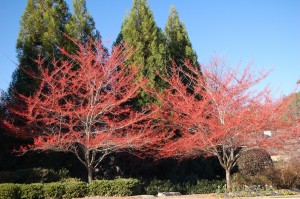A Washington Hawthorn is an excellent ornamental tree that will bring spring color and winter brilliance to your landscape. The Washington Hawthorn is a mid-size tree that bears white flowers in the spring and boasts beautiful red berries throughout the fall and early winter months. Unique Environmental Landscapes chooses this tree for many Atlanta landscapes. Our clients love it.
A Ginkgo Biloba Tree Is a Great Shade Tree and Fall Color Addition
Noted for it’s outstanding brilliant yellow fall color, the Gingko tree is very tolerant and can withstand some pretty harsh conditions. The one thing that must be considered is soil drainage. The Gingko does not like standing water, it prefers a loamy or somewhat sandy soil. It is okay with short droughts, but NOT flooding. It likes a few hours of bright sunlight each day, too much shade could slow the tree’s growth which can grow to enormous heights. At first it grows very slowly and maybe a little crooked, no worries though, it will straighten out and pick up growth after several years.
Low maintenance – The Gingko needs minimal basic fertilization, maybe two times per year. A light layer of mulch at the beginning of each season is adequate. It requires very little pruning unless you want to ‘shape’ the branches which is best done in the spring.
The Gingko plant is readily available at most garden shops. You should know the female variety is fruit producing and this fruit can have a pungent odor. Removing the fruit immediately after it falls helps minimize this problem. Fall is a good time to plant the Gingko or almost any landscape material so it has time to get established before the heat of summer.
Compost Your Leaves This Fall
It’s Aerating and Overseeding Time in Atlanta
After our hot, dry weather most of this summer in Atlanta, mature plants begin to slow down their reproduction rate. Since a blade of grass lives only an average of 45 to 60 days, production of new growth must continually outpace the dieback of older leaves. Young grass will produce new growth faster than older grass. Therefore, one of the most important secrets to maintaining a healthy, thick lawn is to make sure your grass is young. Georgia’s hot, dry summers put additional stress on fescue turf areas so the annual aeration and overseeding of the turf area is very important to establish a healthy stand of grass for 2012.
Unique Environmental Landscapes starts overseeding of fescue lawns in late summer or early fall. We recommend September 15 through October 15. There are many reasons for this. With fall germination, the young grass will have two or three months to become better established before temperatures drop too low and growth stops. The roots will be established before winter, which greatly reduces crop loss should you have a hot, dry spring.
Maintenance that Follows Overseeding ~ Keeping the Seeds Moist
After the aeration & overseeding is done, the seeds will need moisture to germinate. Keep the soil moist (but not overly wet) by lightly sprinkling two times a day throughout the required germination period. After germination, gradually reduce the frequency and increase the time of irrigation watering until a normal irrigation program can be established. Unique will monitor (our landscape maintenance clients) and adjust your irrigation system during this critical period of seed germination.









